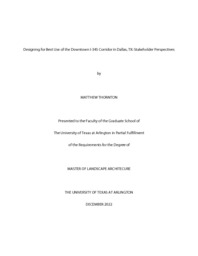| dc.description.abstract | What is a city? It’s more than a location where many people live and work. It is a conglomeration of shared experience over generations. One generation informs the next, which informs how each subsequent generation adds to the development of their shared home. This is what gives each city its own unique form, character, and identity. But what happens if a city repeatedly outgrows itself, disconnects its communities, and demolishes the physical memory of its own cultural history? Dallas, Texas is one such city confronting these issues and is perceived as one without significant place memory or culture (if not history).
The downtown-adjacent neighborhood of Deep Ellum, in particular, has regularly found itself at the heart of this conflict, much of it having been bulldozed in 1969 to make room for I-345, a raised highway that serves as a connection to several major Dallas highways (Maxwell 2020. Like most modern cities, Dallas has largely been designed and planned to accommodate the automobile at the expense of the pedestrian, with I-345 being one of the largest offenders. Deep Ellum and Downtown see some of the city’s heaviest foot traffic but without pedestrian networks, streetscapes, and open spaces that support such activity. Pedestrian pathways between the neighborhoods are few while derelict buildings and parking lots are many.
The purpose of this thesis is to study stakeholders’ spatial preferences and needs, and to design an appropriate replacement for I-345 in Dallas, TX that respect the culture and history of the Deep Ellum neighborhood, improves the connection between Deep Ellum and Downtown, and enhances the identity and economy of the city.
This design master thesis follows a four-step process using qualitative methods (Creswell 2008) to assess stakeholders’ spatial preferences and needs, and to redesign the I-345 corridor in Downtown Dallas, TX for its best use for the future. First, the histories of urban highways and their removal, as well as Deep Ellum and Downtown, are reviewed and documented. Next, four case studies of similarly affected cities are likewise reviewed and documented. One-on-one in-depth interviews are then conducted with seven people who live and work in Deep Ellum and local design and/or community experts. Finally, the spatial qualities of the area are documented using passive site observation, photography, and GIS mapping techniques. The findings from these steps are then used to produce a design vision for the segment of I-345 corridor that resides between Deep Ellum and Downtown Dallas.
The findings illustrate that the best use for this area based on stakeholders’ preferences and needs includes, but is not limited to, uses such as a walkable mixed-use neighborhood, communal green space, promotion of history and culture through public art, and affordable housing. Furthermore, the study concludes a necessity for a depressed highway (I-345) covered with a deck park which connects Downtown and Deep Ellum. As more cities try to correct the design and planning mistakes of the past, landscape architects are uniquely poised to help create new urban connections and green spaces that strengthen their communities. The space occupied by I-345 has the potential to become a new transitional neighborhood that connects Deep Ellum to Downtown, while simultaneously improving the city’s walkability and spotlighting what remains of the rich arts culture of Deep Ellum. Such scrupulous design also has the potential to preserve the culture and history of the Deep Ellum neighborhood, improve the connection between southern Dallas and Downtown, and enhance the identity and economy of the city as a whole. | |



